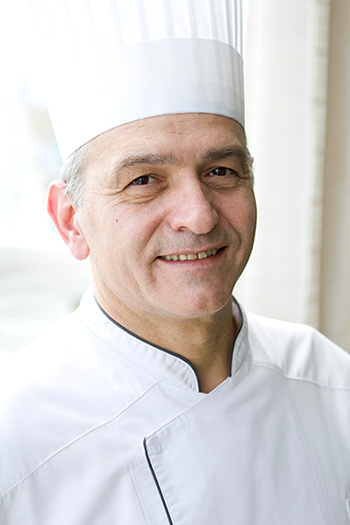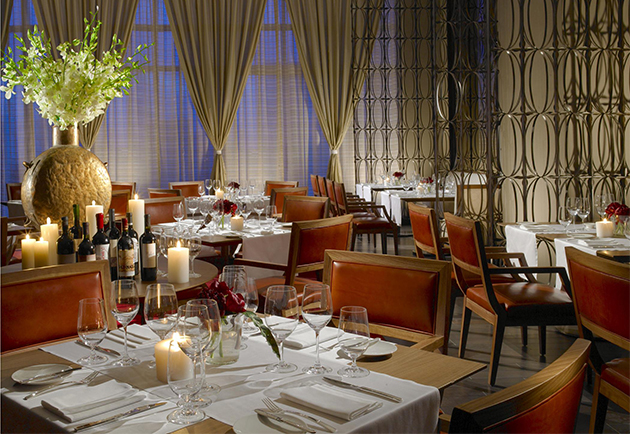
In 2000, Guy Santoro had a difficult decision to make: He was about to leave his country of France and needed to decide where he’d go next. With opportunities in China, Thailand, the Middle East and Mexico City, he ultimately chose Mexico City as his new home, accepting a position at the Hotel Presidente InterContinental Mexico City to open Au Pied de Cochon, a French brasserie.
More than 10 years later, award-winning Santoro is still enjoying his life in Mexico City, or Distrito Federal, as the locals call it. In the intervening years, he became the proprietor of three restaurants in Mexico City — Piazza Navona, Meats Au Charcutier and Rustic Bread Bakery.
Early in 2012, he was appointed executive chef of Diana Restaurant at The St. Regis Mexico City, where he now offers a unique blend of French and Mexican cuisine in one of the finest eateries in town. Forbes Travel Guide caught up with Santoro to get the latest on what he’s doing at Diana Restaurant and his take on what makes Mexico City such an exciting food city right now.
Although you are a French chef, you are based in Mexico City. What makes it an attractive city for you as a chef?
Mexico City is a cosmopolitan city full of different cultures. The population here is more than 20 million. Both aspects make Mexico City one of the most interesting places in terms of gastronomy. Although Mexico City has its own signature cuisine, it’s also an international city; and because of this, it’s a place that’s receptive to new trends and recipes from all over the world. I regard Mexico City as one of the rising culinary centers of the world, and I have been happy to make my home here.
Describe the style of cuisine you’re doing at Diana Restaurant.
At Diana Restaurant, I am doing a special style that is between French and Mexican. What this means is that I use a lot of Mexican products in my food, but use French technique to prepare them. For instance, we have access to excellent seafood from the Baja and areas like Puerto Vallarta. I use a special French technique to marinate the seafood, and combine it with local products like serrano pepper, avocado, mango, pineapple and papaya to make an exotic Mexican fruit ceviche. We serve it with guacamole and corn tortillas; everyone loves it.
Tell me about your trips to the local food markets. Which one is your favorite? What do you have to get when you shop there?
I love going to food markets; I think it is a place where you can find everything you need for cooking any kind of dish. My favorites are San Juan Market, Central de Abasto and La Lagunilla Market. Because the products are always changing with the seasons, it’s important to go to the market to get the best available products at that time. We have a lot of chilies that you don’t find in France. There are hot chilies, medium, some with smoked flavors. The possibilities that we have with chilies are incredible. We also have different types of tomatoes — green, heirloom — you can find a lot of tomatoes in the summer. You can also find exotic products like chapulines (grasshoppers). I don’t use these kinds of products, but it is a part of Mexican cuisine. However, we do have fresh escargots and an excellent selection of wild mushrooms like morel and chanterelle. Summer is the period of the wild mushroom, and you can find everything that we would have in Europe at the local markets here in Mexico City.
Diana Restaurant has one of the best Sunday brunches in the city. What makes it so special?
We offer a variety of dishes, changing them out weekly with Mexican themes based on the different cities of the country. For instance, when we’re focusing on a seaside theme, we might offer a ceviche bar, a sushi bar and a raw bar, which we might offer with made-to-order omelets, hot menu items and a carving station with prime rib. The brunch features bottomless champagne and a dessert station with approximately 40 choices — everything from mini cakes to churros, housemade chocolates and cookies, meringues, éclairs and custards. Then on the patio, there is a panoramic view of the city, where you can see iconic historical monuments like the Angel of Independence, the Fountain of Diana the Huntress, the Pillar of Light and the Chapultepec Castle. You get the beautiful surroundings, a wonderful assortment of food and a fantastic view, which makes it a very special way to spend a Sunday morning.
Tell us about some of the trends you’re seeing in the Mexico City dining scene right now.
Basically, it’s all about Mexican cuisine right now. Everybody is talking about Mexican cuisine and trying to get back to their roots, doing Mexican cuisine in a new way. We have a lot of Mexican restaurants with great chefs: Enrique Olvera of Pujol and Jorge Vallejo of Quintonil right here in Mexico City; in Oaxaca, there is Alejandro Ruiz of Casa Oaxaca Hotel; and Guillermo González Beristáin of Pangea in Monterrey. The trend is to use organic products — vegetables, chicken, fruit — with old Mexican cuisine techniques and flavors to create something that is more current. Some Mexican chefs started planting their own vegetables in chinampas in Xochimilco. A chinampa is an ancient way of planting vegetables on a boat that is anchored in a lagoon so that it absorbs the water from the lagoon, where the vegetables get all the nutrients from. I have a project to start my own vegetable garden at The St. Regis Mexico City so I can obtain the freshest vegetables to cook with.
What are your favorite things to eat and places to dine when you’re not at Diana Restaurant?
My favorites dishes are any kind of salads, fish, seafood, organic chicken and, as a good Frenchman, bread, wine and cheese. If I am not at Diana Restaurant, I like to go to other chefs’ restaurants — Enrique Olvera’s Pujol, Eduardo García’s Maximo Bistrot, Jorge Vallejo’s Quintonil, or Edgar Núñez’s Sud 777. I know all of these chefs. I enjoy going to an Argentine steakhouse — I enjoy a place called Cambalache. There is another one, Mexsi Bocu, which does Mexican-French in La Condesa. They will do local products with French technique, like a beef stew with mole. They would use French technique to cook the meat, then put mole in it, so like bourguignon with a mole.
Photos Courtesy of Starwood Hotels and Resorts Worldwide Inc


